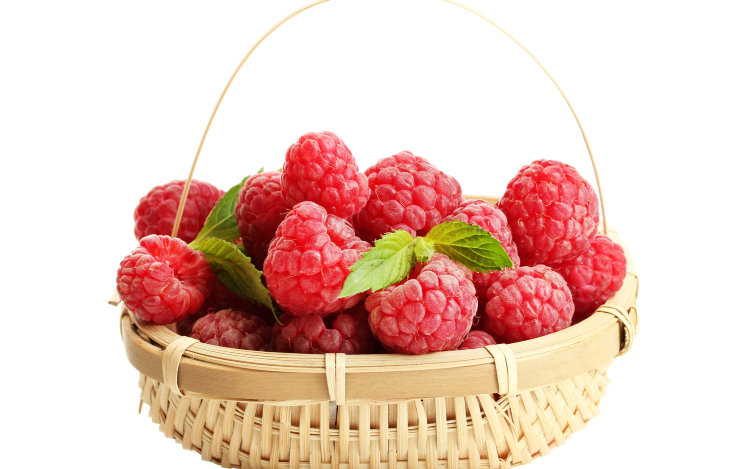- Overview
Common name: Raspberry
Botanical name: Rubus idaeus Family: Rosaceae
Avg. Height: Varies Bush Raspberry Bush in a 3 Gallon Container. Despite originating from the lower Himalayas, the Raspberry grows and fruits extremely well throughout Florida. The fruit are the size of a nickel, extremely flavorful, and a favorite among kids. The plants do go dormant in the winter, and new canes sprout in the spring. Cold Hardy and can be grow in a container. Good source of anti-oxidants.
Description
The Raspberry or Red Raspberry (Rubus idaeus) is a plant that produces a tart, sweet, red composite fruit in summer or early autumn. In proper botanical language, it is not a berry at all, but instead an aggregate fruit of numerous drupelets around a central core. In raspberry and other species of the subgenus Idaeobatus, the drupelets separate from the core when picked, leaving a hollow fruit, whereas in blackberry the drupelets stay attached to the core. The black raspberry, also called a blackcap, is not the same plant, being a variety (usually) of Rubus occidentalis, a North American species. Other Rubus species also called raspberries include: Arctic raspberry (Rubus arcticus) Flowering raspberry (Rubus odoratus) Wine raspberry (Rubus phoenicolasius) Whitebark raspberry or Western Raspberry (Rubus leucodermis) Bramble raspberry or Blackberry (Rubus fruticosus) Not all of these are included in the same subgenus. It typically grows in forest clearings or fields, particularly where fire or wood-cutting has produced open space for colonization by this opportunistic colonizer of disturbed soil. The raspberry flower can be a major nectar source for honeybees. As a cultivated plant in moist temperate regions, it is easy to grow and has a tendency to spread unless cut back. Two types are commercially available: the wild-type summer bearing, that produces an abundance of fruit on second-year canes within a relatively short period in midsummer, and double- or "ever"-bearing plants, which also bear a few fruit on first-year canes in the autumn, as well as the summer crop on second-year canes. In the United States, raspberries can be cultivated from USDA plant hardiness zones 3 to 9. Leaves of the raspberry cane are used fresh or dried in herbal and medicinal teas. The leaves have an astringent flavour and in herbal medicine are reputed to be effective in regulating menses. Leaves are found in groups of 3 or 5 and the undersides are silver-white in color. Blackberries have similar looking leaves but the undersides are green. Raspberries contain significant amounts of polyphenol antioxidants, chemicals linked to promoting endothelial and cardiovascular health. Xylitol, a sugar alcohol alternative sweetener, can be extracted from raspberries. Raspberries are considered a high-fiber food at over 8 grams dietary fiber per cup. They are an excellent source of vitamin C and manganese, a good source of vitamin K and magnesium and contain some calcium and iron.
Growing
Raspberries are grown for two reasons: for the fresh market and for commercial processing. Traditionally raspberries were a late summer crop, but with new technology, varieties and innovations, raspberries can be enjoyed all year-round. Raspberries need a lot of sun and ample amounts of water in order to develop to their fullest. Escaped raspberries frequently appear as garden weeds, spread by seeds found in the excrement of birds.
Culture
Raspberries are normally started in the winter from dormant canes. These should be planted 1 m apart in fertile, well drained soil. Prepare the soil before planting by digging deeply and incorporate plenty of organic matter, such as compost. In the first year, remove all flowers to allow the plant to build up reserves and to grow bigger. From the second year, previous year's canes will flower in the spring and the fruit will ripen in the summer. Water and feed well in the spring and summer, but decrease water and food in the autumn. This will harden the canes to survive the winter. In the winter, prune out old flowered canes, down to the ground level. Of the new canes, remove all small and weak ones. Remove ones that are growing too close to each other - allow around 10-15 cm between canes. Most varieties will need to be staked. Raspberries are very vigorous and can be a little invasive. They propagate using basal shoots (also known as suckers); extended underground shoots that develop roots and individual plants. They can sucker new canes some distance from the main plant. For this reason, raspberries spread well, and can take over gardens if left unchecked. In the spring, mark out the boundary of the plant and push a spade straight down the boundary. This will sever the suckers. Then dig out the suckers that grow outside the boundary. Pick the fruits when they have turned a deep red and drop off easily from the core when touched. This is when the fruits are most ripe and sweetest. Excess fruit can be made into raspberry jam or frozen. - Features
weight: 9.99 lbs : - ReviewsThere is no reviews yet...Be the first!
Be the first to write a review of this product!





